About the Exhibition
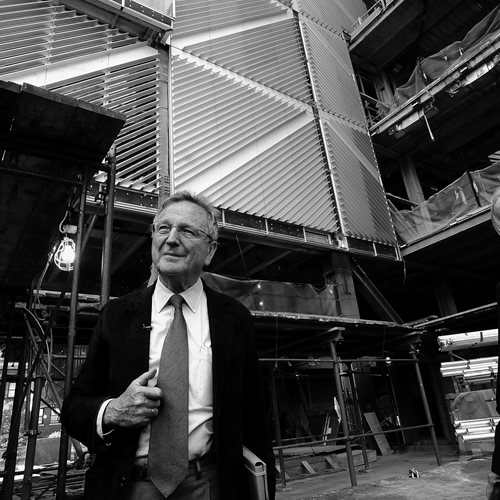
Portrait of Rafael Moneo
On site during construction of the laboratories in the Columbia University Northwest Corner Building, New York
The School of Madrid (until 1968)
The young architect Rafael Moneo began his career pursuing the organic style of the so-called ‘Madrid school’, a functionalist architecture that took on expressive forms while keeping to the modern logic of constructive honesty. Moneo, however, never altogether succumbed to the Madrid school, and his proposal for a broadcasting station on Santiago de Compostela’s Plaza del Obradoiro, already in 1962, attests to this. Although the design bore typical elements of Madrid organicism, filtered by a very personal expressivity, the delicate articulation and fragmentation of the pieces in relation to the context, its modest scale, and its carefully made construction choices demonstrate Moneo’s early sensitivity to the urban context and his belief in the idea of architecture rising to its own circumstances.
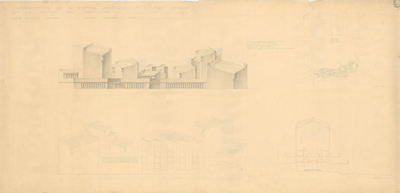
Broadcasting Station in Obradoiro Square
Santiago de Compostela, Spain, 1962
Competition for a Fellowship at the Spanish Academy in Rome
Elevations, site plan and section
Pencil on cardboard
87x185cm
First mature works (until 1976)
At the end of the 1960s Moneo concentrated on preparing to compete for a university professorship. This was his first chance to put order to his architectural thinking. The result of this reflection was an architectural design teaching programme which granted him the Elements of Composition Professorship at the Barcelona School, beginning in 1970. In his programme Moneo made history the core of an approach to design, considering it a body of knowledge that provides architects with a set of solutions already tested by others. This position was reflected in his work, and direct use of solutions previously applied by Asplund, Gardella, Terragni, Sullivan, and even contemporary architects such as Rossi, Venturi, and Stirling began to be recurrent in his projects. The new design approach also involved questioning the formal coherence of Madrid School organicism, as well as reconsidering composition as a design tool for an architecture made of different parts. Composition aside, Moneo also put forward a new theory of architectural form that could give buildings a structuring principle once they were atomized into parts. It is in his most acclaimed works of the period such as Bankinter (1972–6) or Logroño City Hall (1973–81) that this approach to design reached its full potential.
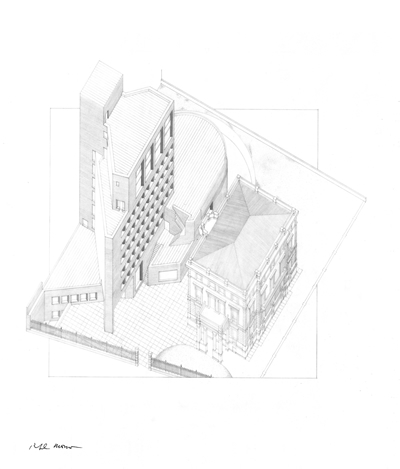
Bankinter Headquarters
Madrid, 1972-1976
Axonometric view
Pencil on paper
61x49.5cm
Between Madrid and New York (until 1984)
From 1976 to 1977 Moneo took a sabbatical year from the Barcelona School to accept Peter Eisenman’s invitation to the Institute for Architecture and Urban Studies in New York. During this first American stint he was invited by John Hejduk to be a visiting professor at Cooper Union, and the next year the invitation was to Princeton. The relationship with these two architects, as well as Gandelsonas, Silvetti, Vidler and European architects such as Stirling and Koolhaas, then in New York, opened new intellectual perspectives. In 1980 he left Barcelona to accept a Composition Professorship in the Madrid School, and his axis of action became Madrid-New York. Starting in the late 1970s, Moneo’s work combined a continuation of his reflections on urban typology and morphology with more controversial proposals, taking on a greater formal and linguistic complexity. The National Museum of Roman Art in Mérida (1980-6) best represents this attitude. The building’s structure, defined by an axonometric projection inspired in drawings by Choisy, condenses scales, urban layers, and construction systems, as if the building’s condition could be absorbed into a single but extraordinarily complex formal entity.
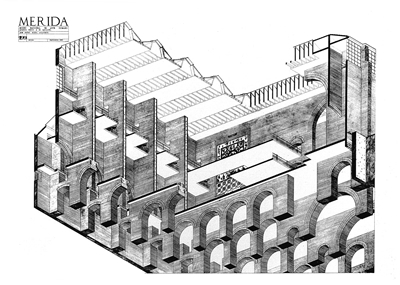
National Museum of Roman Art
Mérida, Spain, 1980-1986
Axonometric view
Pencil on sketching paper
107.6x130.1cm
Harvard (until 1990)
Moneo’s first transatlantic contacts were very rewarding. Soon he became much respected in America. A result of this was his appointment in 1985 as director of the architecture department at Harvard, for which he and his family lived in Cambridge, Massachusetts, for five years. Held in esteem both in academe and for his professional work, Moneo’s arrival brought a revival of focus, in the United States, on the importance of the built work and the need to reestablish the connection between theoretical thought and construction, in opposition to the limitation to mere graphic speculation then prevailing in American universities. From the mid-1980s on, Moneo’s buildings were more independent of the direct dictates of morphological consistency in the city. Some of his projects took on more categorical scales and became great infrastructural pieces like Atocha Station (1984-92).
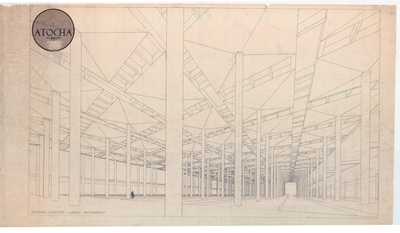
Atocha Station Extension
Madrid, Spain, 1984-1992
Competition First prize
Perspective view
Pencil on sketching paper
86.5x143.5cm
The return to Madrid and the international recognition (until 1999)
In 1990, commitments in Spain made Rafael Moneo end his stint at the helm of the architecture department of Harvard’s Graduate School of Design, and he returned to Madrid for good. So began the years of worldwide acclaim and prestigious distinctions including the Pritzker Prize in 1996. Moneo during this period took on major international importance and became a figure in the emerging global ‘star system’. The more he became part of this world scene, however, the more his discourse stressed the importance of the site in the design process. In Moneo’s view, the site does not necessarily dictate the architecture to be built. Rather, it must be interpreted, built reciprocally, and sometimes even confronted. In line with these thoughts, his designs of that period are imbued with the spirit that rose from site conditions. The abstract elevation that negotiates the tension between the cathedral and the episcopal palace in the annex of the Murcia City Hall (1991-8) is one of the built manifestations of Moneo’s theoretical reflections.
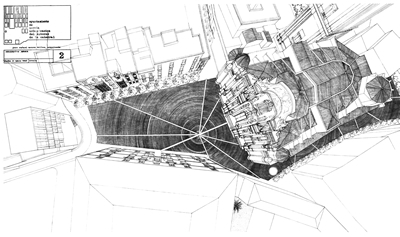
Murcia City Hall Extension
Murcia, Spain, 1991-1998
Perspective view
Ink on tracing paper
62x109.5cm
A reflective professional practice today (to this day)
The beginning of the 21st century brought a new wave of acknowledgements for Rafael Moneo’s career, such as the RIBA Gold Medal (2003) or the Prince of Asturias Arts Prize (2012). Also during this period, the critical-reflective activity carried out throughout his career acquired renewed intensity and culminated in the publication of Theoretical Anxiety and Design Strategies in the Work of Eight Contemporary Architects (2004). In this work, which results to a great extent from his teaching at Harvard, where he was a Josep Lluís Sert Professor of Architecture, Moneo reflects on the theories that underpin the formal principles followed by contemporary architects that interest him most, as well as their validity when it comes to the reality they are faced with. Moneo would later apply this kind of reflection to his own work as an architect, and would publish Remarks On 21 Works (2010), where it became clear that each of his buildings renders a theoretical reflection that depends on how the architect sees the particular circumstances of each work. This plural response, which intends to deal directly with the complexity and even the contradictions that exist in the reality of each project, is found in Moneo’s work, but can be seen more clearly in the buildings that relate to this period, such as the Northwest Corner Building at the Columbia University (2005-2010).
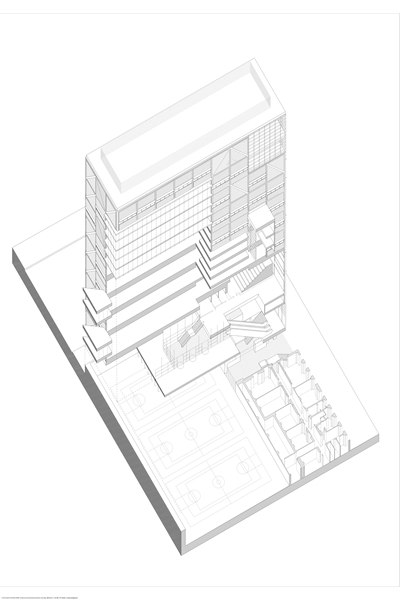
Northwest Corner Building, Columbia University
Broadway/120st, New York, USA, 2005-2010
In collaboration with Moneo-Brock Estudio
Axonometric view
Digital archive, print on tracing paper
57.6x43.4cm